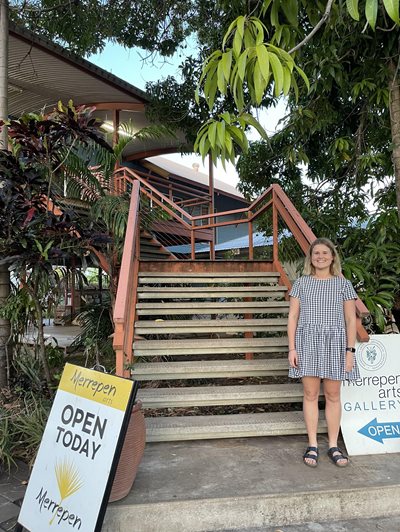Supporting First Nations Artists in the Northern Territory
In July 2022, Kate Macfarlane spent a week in the Northern Territory providing legal advice to First Nations artists through the Arts Law Centre's (ALC), Artists in the Black program.
Kate shares her journey to the Art Centres, her work and the importance and impact of buying direct from Aboriginal Art centres:
"The key learning I took away from the trip was the importance of supporting Aboriginal artists by buying authentic works direct from the artists, or community enterprises like the Arts Centres we visited. The proceeds of sale go directly to the artists, and with the artists having finalised wills, these sales have the ability to support their families and communities now and in the years to come."
The Artists in the Black Program
Since 2017, the Colin Biggers & Paisley Foundation has worked in collaboration with the ALC to assist in protecting the cultural and artistic rights of Indigenous artists by providing pro bono support to their Artists in the Black program. The Artists in the Black Program forms part of ALC's community outreach program where solicitors travel to remote communities to provide legal advice and draft wills for Aboriginal artists.
Arts Law - Artists in the Black Nauiyu Trip. By Kate Macfarlane
On the Monday I met with Donna Robinson in Darwin. Donna is a solicitor at Arts Law, who practises in Intellectual Property and Copyright Law, and has travelled to remote Art Centres all over Australia drafting wills for artists and assisting with general legal enquires the artists may have - mainly questions regarding intellectual property, licensing, and copyright.
From Darwin we drove 3 hours south to Daly River, a beautiful remote area known for its mango farms and barramundi fishing. From our accommodation it was a 20-minute drive to Nauiyu, a small community on the banks of the Daly River where the Merrepen Arts Centre is located. Merrepen has around 130 member artists working in a variety of traditional and contemporary mediums. The Art Centre itself was filled with beautiful artworks on canvas, silk, fabric and bark - a real testament to the local talent.

Donna and I, with the help of her daughter Lucia, spent two days drafting wills for artists at Merrepen. We set up in a shaded area outside where the artists could drop by for a chat and to obtain legal advice. We spoke to the artists about the importance of creating a will, especially because their artwork has the ability to generate income through copyright and licensing agreements after they pass away. Many artists had close connections with extended family whom they wanted to share this future income with, and drafting wills was integral to ensuring this income would be allocated according to the artists' wishes.
In addition to drafting wills, we also enjoyed hearing from the artists about their work and their lives at Nauiyu. We met an artist whose work is in several major collections, including the National Gallery of Australia and the Myer Collection. Another local artist told us about how she uses local flora and fauna to make natural dyes for fabric art, and before we left, we were lucky enough to meet an Aboriginal Elder from Nauiyu who is known Australia wide as an artist, activist, writer and public speaker.
On Wednesday, we travelled 3 hours southeast of the Daly River to Katherine, and then another 118 km east to Beswick, a community located on the banks of the Waterhouse River. Beswick is home to Djilpin Arts, which is a small Art Centre selling the artwork of approximately 20 local artists. The Art Centre was a beautiful space filled with weaving, earrings, textiles and paintings. We set up outside on the porch and spent most of our day revisiting and amending wills that had been drafted when Arts Law last visited 6 years ago.


A highlight of Djilpin was meeting a senior Mayali man who is a master of Mago (West Arnhem didjeridu).This artist spent time telling us about his childhood in Beswick and even told us how to find termite hollowed tree trunks to make didjeridu with.
Our final day was spent at Mimi Arts in Katherine. Established in 1978, Mimi Arts is a 100% Aboriginal community-owned not-for-profit art centre which represents artists from the entire Katherine region. The Arts Centre is new and has a gallery space filled with paintings and carvings, as well as a shop and studio for the artists to work. We spent our day at Mimi drafting new wills and revisiting old wills that needed updating.
While at Mimi we met an artist from Alice Springs whose many works were largely dot paintings typical of the central desert region. This artist was extremely generous with her time, showing us her artworks and telling us what various aspects of the paintings meant. Her vibrant paintings in the gallery were of people, wooden coolamons (traditional baby baskets), women's ceremonies and bush tucker, including sugar leaf and wild passion fruit. We also met another artist whose paintings were of bush tucker - she was insistent on showing us her work, so we knew what to eat if we were ever lost in the bush, which was fascinating (and much appreciated!).
Overall, I was struck by the generosity, kindness and humility of these incredibly talented artists. Their works are inspired by their experiences, their ancestors, their communities and the nature around them. The Arts Centres are often the lifeblood for these small communities; they are meeting places and an important way for these remote communities to generate income.